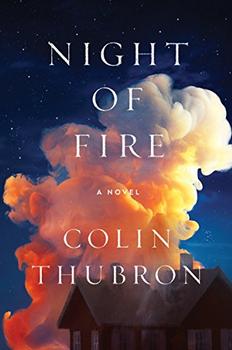Summary | Excerpt | Reviews | Beyond the book | Read-Alikes | Genres & Themes | Author Bio

You've probably been there. On your way from one place to another, stuck in an airport or train station while mechanical difficulties, or labor disputes, or, most likely, weather conspired to make what you thought would be a mere blip on your journey into something resembling its own destination. That's the scene at the start of Jane Urquhart's The Night Stages – Tamara, fleeing mid-twentieth century Ireland for the United States after escaping a particularly self-destructive affair with a married man, finds herself marooned in Gander, Newfoundland when a routine fuel stop turns into a multi-day grounding thanks to impenetrable fog.
While she's there, Tam considers two things: the evocative and seemingly allegorical mural that defines the airport's waiting area, and the history of her turbulent relationship with Niall, the man who broke her heart a seemingly infinite number of times. As we learn Tam's story and watch her assign personal meaning and significance to the figures that make up the mural, we also are given glimpses into the lives and passions of two men: Kenneth Lochhead, the (real-life) Canadian painter who created the mural, and Kieran, the troubled and reclusive younger brother of Niall.
Although Tam's story (and Kenneth's, too) is certainly compelling, Kieran's story is ultimately where the emotional heart of The Night Stages resides. Kieran, whose mother died tragically when he was still quite young, grew up in the golden shadow of his older brother, Niall. Tormented by erratic behavior and outbursts, and tending toward aimlessness, Kieran feels truly free and focused only when he's in the saddle of the Purple Hornet, the bicycle on which he rides vast distances through the mountains of Ireland's County Kerry. When he connects with a wise and mysterious fisherman who also happens to be a gifted poet and a visionary coach, Kieran begins to view his connection to the land and its folklore in a new way, and to embrace the idea of training for an event that might redeem him in the eyes of his family and himself.
Urquhart tells all these rich and complex stories in language that is simultaneously deliberate and lyrical. The voice of Kieran's mentor, Michael Kirby, is particularly warm and wise. Here he articulates for Kieran the fundamental hopefulness in basic human behaviors: "The future … is the geography with which we are sometimes most intimate, having gone over every version of it inch by inch in our minds. We spend inordinate amounts of time anticipating it, picturing it, trying to control it, measuring it, taking it apart and reassembling it. When we are preparing food, we are preparing for the future … When we wake in the morning, we step onto the floor and into the future. When I begin to compose a poem, I do so because in the future, I imagine, there will be this wonderful poem."
The three separate narrative strands that make up Urquhart's novel could have come off as three separate and disjointed novellas rather than a unified whole. But Urquhart, an accomplished and award-winning prose stylist, seems to handle this kind of narrative balancing act with ease, uniting the various stories, not only through character and circumstance, but also through theme.
Her primary characters all struggle with the vast gulfs that can grow between one's hopes and one's reality. They all, at one point or another, spend time waiting for the object of that hope to arrive. All three spend more time in love with the idea of a person than with that person. And, most of all, the idea of flight runs through all three stories, more or less literally: Tam thinks back fondly and regretfully of her years spent flying fighter planes as an auxiliary pilot during World War II, Kieran strives to capture the feeling of flight on his bicycle, and the artist Kenneth Lochhead aspires to visually encompass various metaphors of flight in the mural at the novel's center. Certainly there are many other possible points of intersection between and in these three stories; discovering and discerning them makes the reader's job one of pure joy and satisfaction.
![]() This review was originally published in The BookBrowse Review in August 2015, and has been updated for the
January 2017 edition.
Click here to go to this issue.
This review was originally published in The BookBrowse Review in August 2015, and has been updated for the
January 2017 edition.
Click here to go to this issue.

If you liked The Night Stages, try these:

by Colin Thubron
Published 2018
Award-winning, bestselling novelist and travel writer Colin Thubron returns to fiction with his first novel in more than a decade, a searing, poetic masterwork of memory.

by Kate Atkinson
Published 2016
The stunning companion to Kate Atkinson's #1 bestseller Life After Life, "one of the best novels I've read this century" (Gillian Flynn).
Your guide toexceptional books
BookBrowse seeks out and recommends the best in contemporary fiction and nonfiction—books that not only engage and entertain but also deepen our understanding of ourselves and the world around us.